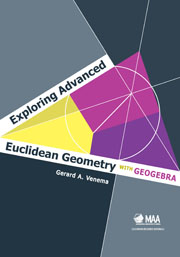Book contents
- Frontmatter
- Preface
- Contents
- 0 A Quick Review of Elementary Euclidean Geometry
- 1 The Elements of GeoGebra
- 2 The Classical Triangle Centers
- 3 Advanced Techniques in GeoGebra
- 4 Circumscribed, Inscribed, and Escribed Circles
- 5 The Medial and Orthic Triangles
- 6 Quadrilaterals
- 7 The Nine-Point Circle
- 8 Ceva's Theorem
- 9 The Theorem of Menelaus
- 10 Circles and Lines
- 11 Applications of the Theorem of Menelaus
- 12 Additional Topics in Triangle Geometry
- 13 Inversions in Circles
- 14 The Poincaré Disk
- References
- Index
- About the Author
2 - The Classical Triangle Centers
- Frontmatter
- Preface
- Contents
- 0 A Quick Review of Elementary Euclidean Geometry
- 1 The Elements of GeoGebra
- 2 The Classical Triangle Centers
- 3 Advanced Techniques in GeoGebra
- 4 Circumscribed, Inscribed, and Escribed Circles
- 5 The Medial and Orthic Triangles
- 6 Quadrilaterals
- 7 The Nine-Point Circle
- 8 Ceva's Theorem
- 9 The Theorem of Menelaus
- 10 Circles and Lines
- 11 Applications of the Theorem of Menelaus
- 12 Additional Topics in Triangle Geometry
- 13 Inversions in Circles
- 14 The Poincaré Disk
- References
- Index
- About the Author
Summary
We begin our study of advanced Euclidean geometry by looking at several points associated with a triangle. These points are all called triangle centers because each of them can claim to be at the center of the triangle in a certain sense. They are classical in that they were known to the ancient Greeks. The classical triangle centers form a bridge between elementary and advanced Euclidean geometry. They also provide an excellent setting in which to develop proficiency with GeoGebra.
While the three classical triangle centers were known to the ancient Greeks, the ancients missed a simple relationship between them. This relationship was discovered by Leonhard Euler in the eighteenth century. Euler's theorem serves as a fitting introduction to advanced Euclidean geometry because Euler's discovery can be seen as the beginning of a revival of interest in Euclidean geometry and most of the theorems we will study in the text were discovered in the century after Euler lived. Euler's original proof of his theorem was a complicated analytic argument, but it is simple to discover (the statement of) the theorem with GeoGebra. See Chapter 7 of [6] for a nice discussion of Euler's contributions to geometry.
- Type
- Chapter
- Information
- Exploring Advanced Euclidean Geometry with GeoGebra , pp. 23 - 30Publisher: Mathematical Association of AmericaPrint publication year: 2013



